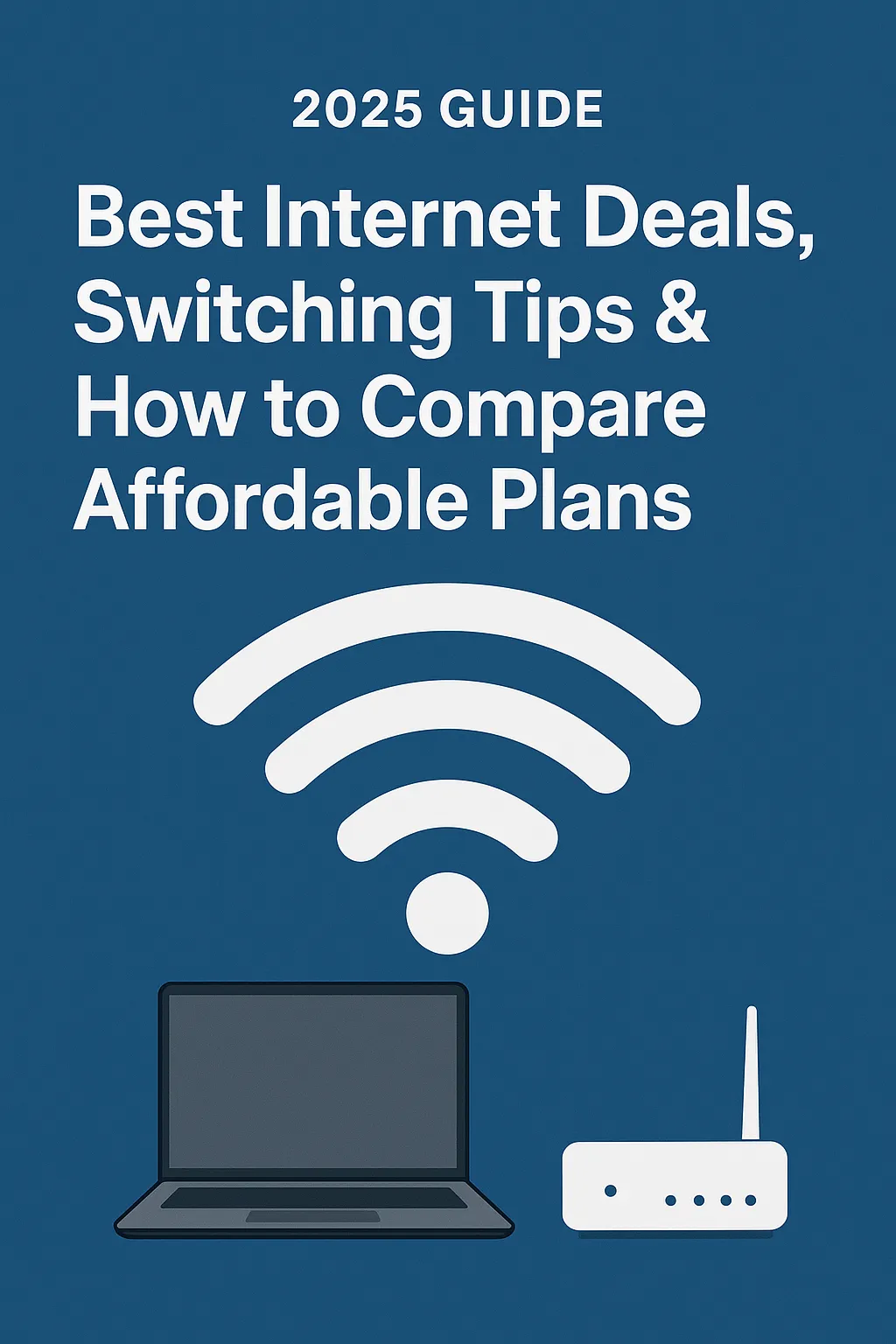2025 Guide: Best Internet Deals, Switching Tips & How to Compare Affordable Plans
In today’s connected world, finding the best internet provider deals isn’t just about price—it’s about matching your household’s needs with the right speed, reliability, and value. With dozens of providers and hundreds of plans, it’s easy to feel overwhelmed. This guide breaks down the best internet deals, how to compare plans, tips for switching providers, and how to find affordable packages that actually work for you.
 Best Internet Provider Deals: How to Save Big in 2025
Best Internet Provider Deals: How to Save Big in 2025
In today’s connected world, finding the best internet provider deals isn’t just about price—it’s about matching your household’s needs with the right speed, reliability, and value. With dozens of providers and hundreds of plans, it’s easy to feel overwhelmed. This guide breaks down the best internet deals, how to compare plans, tips for switching providers, and how to find affordable packages that actually work for you.
What Are the Best Internet Provider Deals in 2025?
As of July 2025, several major providers are offering standout promotions, especially for new customers. T-Mobile Home Internet, for example, is currently offering a five-year price guarantee on its 5G Home Internet plans, with prices ranging from $50 to $70 per month (with AutoPay, taxes and fees included). Speeds vary from 87 to 415 Mbps, which is more than enough for most households. New customers can also receive up to a $300 reward card when signing up by July 23, plus free access to Hulu (With Ads) and Paramount+ Essentials on select plans. Installation and equipment are free, with no hidden fees or annual contracts[1].
Other providers are also competing aggressively. Mediacom offers one of the nation’s cheapest plans at $19.99 per month for 250 Mbps, though equipment fees and data caps may apply. WOW (WideOpenWest) provides fiber and cable plans starting at $30 per month for 100 Mbps, with higher speeds available. Frontier’s fiber plans start at $29.99 per month for 200 Mbps, with no data caps or contracts, though prices may increase after the first year[3].
When evaluating deals, always look beyond the headline price. Consider installation fees, equipment costs, data caps, contract terms, and whether the price is guaranteed or subject to increase. The best deal for you depends on your location, usage, and whether you qualify as a new customer.
How to Compare Internet Plans Like a Pro
Comparing internet plans requires more than just looking at monthly costs. Here’s a step-by-step approach to ensure you’re making an informed decision:
Step 1: Assess Your Needs
Start by estimating how much speed your household requires. For light use (email, browsing, streaming on one device), 25–50 Mbps may suffice. For multiple users streaming HD video, gaming, or working from home, aim for at least 100–200 Mbps. Larger households or heavy users may need 500 Mbps or more.
Step 2: Check Availability
Not all providers serve every area. Use provider websites or third-party tools to check which services are available at your address. Availability can vary even within the same city, so always verify with your exact location.
Step 3: Compare Key Features
Create a comparison table for the plans you’re considering. Key columns should include:
ProviderPlan NameDownload SpeedUpload SpeedMonthly PriceEquipment FeesData CapContractPromotionsT-Mobile5G Home Internet87–415 MbpsVaries$50–$70NoneNoneNone$300 reward card, 5-year price lockMediacomXtream 250250 MbpsVaries$19.99YesYesPossibleNone specifiedWOWFiber 100100 MbpsVaries$30PossiblePossiblePossibleNone specifiedFrontierFiber 200200 MbpsVaries$29.99PossibleNoneNoneNone specified
This table is a starting point—always confirm the latest details directly with each provider, as offers and terms change frequently.
Step 4: Read the Fine Print
Look for asterisks and footnotes. Promotional prices often expire after 12–24 months, and equipment fees can add $10–$15 per month. Some providers require a credit check or charge installation fees. Data caps may result in overage charges or throttled speeds.
Step 5: Check Customer Reviews
Provider reputations matter. Sites like Allconnect publish customer ratings—Frontier Fiber, for example, scores 4.12 out of 5, while Mediacom and WOW are in the 3.8–3.9 range[3]. Look for feedback on reliability, customer service, and how providers handle outages or billing issues.
Step 6: Consider Bundling
If you need home phone or TV, bundling can save money. Some providers, like T-Mobile, offer perks such as streaming subscriptions with certain plans[1].
Switching Internet Providers: Tips for a Smooth Transition
Switching providers can save you money and improve your service, but it requires planning. Follow these steps to avoid downtime and billing headaches.
Step 1: Research and Compare
Use the comparison steps above to identify your best options. Don’t just focus on price—consider reliability, customer service, and any perks or bundles.
Step 2: Check for Early Termination Fees
If you’re under contract with your current provider, check if you’ll owe an early termination fee (ETF). Some providers waive ETFs if you’re moving to an area they don’t serve.
Step 3: Schedule Your Switch
Contact your new provider to schedule installation. Try to overlap services by a few days to avoid losing connectivity. If possible, keep your old service active until the new one is working reliably.
Step 4: Return Equipment
Most providers require you to return modems, routers, or set-top boxes. Keep the receipt or tracking number as proof of return to avoid unexpected charges.
Step 5: Cancel Your Old Service
Once your new service is up and running, cancel your old one. Confirm the cancellation in writing and request a final bill. Check for any prorated charges or refunds.
Step 6: Set Up Your New Network
Follow the new provider’s instructions to set up your Wi-Fi network. Update passwords and reconnect your devices. Test speeds and connectivity in different parts of your home.
How to Find Affordable Internet Packages
Affordable internet is within reach if you know where to look and what to ask for. Here’s how to find budget-friendly options:
Look for Low-Cost Plans
Some providers offer plans as low as $20 per month, though speeds may be limited[2]. These are often sufficient for light users or those on a tight budget. Always check if the plan includes equipment or if fees will increase the total cost.
Check for Government and Nonprofit Programs
Programs like the FCC’s Affordable Connectivity Program (ACP) provide monthly discounts on internet service for eligible households. To see if you qualify, visit the Federal Communications Commission’s official website and search for “Affordable Connectivity Program” or contact your local provider for details. Many providers participate in these programs and can help you apply.
Negotiate With Your Current Provider
If you’re happy with your service but not the price, call your provider and ask for a better deal. Mention competitor offers—providers often have retention departments with the authority to match or beat competing prices[4].
Consider Prepaid or No-Contract Options
Prepaid internet plans and month-to-month contracts offer flexibility and avoid long-term commitments. These can be ideal for renters or those who may move soon.
Explore Local and Regional Providers
Smaller, regional providers sometimes offer competitive rates and personalized service. Check local listings or ask neighbors for recommendations.
Real-World Examples: How Households Are Saving
Consider a family of four in a suburban area. They stream movies, play online games, and have two adults working from home. After comparing plans, they choose T-Mobile’s 5G Home Internet at $50 per month with a five-year price guarantee, no equipment fees, and a $300 reward card. Their previous provider charged $75 per month with a $15 equipment fee and a 12-month contract.
A single retiree on a fixed income qualifies for the ACP and gets a $30 monthly discount on a $20 plan from a local provider, effectively paying nothing for basic internet access.
A young professional in an apartment building switches from a cable provider to a fiber plan from Frontier, paying $29.99 per month for 200 Mbps with no data cap or contract, saving $25 monthly compared to their old plan.
Potential Challenges and Solutions
Switching providers isn’t always seamless. Here are common challenges and how to address them:
Service Gaps During Transition
Overlap your old and new services by a few days. Use mobile hotspot data as a backup if needed.
Installation Delays
Schedule installations as early as possible. Confirm appointment times and follow up if technicians are late.
Billing Errors
Review your first bill from the new provider carefully. Dispute any incorrect charges promptly.
Equipment Compatibility
Some providers require their own modem or router. Ask in advance if you can use your own equipment to save on rental fees.
Key Takeaways
- Shop around: Compare multiple providers and plans using speed, price, fees, and contract terms.
- Look beyond the price: Consider installation, equipment, data caps, and customer service.
- Switch strategically: Avoid service gaps, return old equipment, and confirm cancellation.
- Explore affordability programs: Government and nonprofit discounts can make internet access free or nearly free for eligible households.
- Negotiate: Don’t hesitate to ask your current provider for a better deal.
How to Get Started
Begin by listing your household’s internet needs and budget. Use provider websites or third-party comparison tools to check availability and current offers. For government assistance, visit the Federal Communications Commission’s official website and search for “Affordable Connectivity Program.” When ready to switch, contact your chosen provider to schedule installation and confirm all terms in writing.
By following these steps, you can find the best internet provider deals, compare plans effectively, switch providers with confidence, and access affordable internet packages tailored to your needs.











